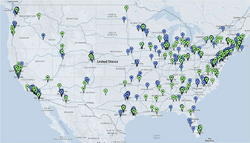
Nov. 16, 2017
By: Michael Feldman
HPC market analyst firm Hyperion Research has released an online interactive tool that maps more than 750 high performance computing sites across the United States.
It breaks these out into 168 government or academic sites (marked in green) and 589 industry sites (marked in blue). The sites aren’t just HPC user sites, but also include the office locations of businesses that offer high performance computing products or services.
The tool provides a geographical mapping of these HPC sites and allows you to zero in on specific states, cities, or congressional districts. Sites can also be searched individually by name. When you click on one, you get a pop-up that shows pertinent facts about the organization, like its address and phone number, its economic sector, the number of employees that work there, its size (in US dollars), and the congressional district where it’s located.
![]()
HPC sites in northern end of Silicon Valley in California
The last three data items are important since one of the purposes of the tool is to make government representatives and voters aware of HPC-related economic activity in their area and how it contributes to the local economy. For example, in the 19th Congressional District of Texas, represented by Congressman Louie Gohmert, HPC site Texas Tech University employs 6,635 employees and brings $926 million per year to the local economy.
It might interest Congressman Gohmert and his constituents to know that in 2010 he voted against a science and technology funding bill (HR5116), which allocated $84 billion across federal agencies that feed some of their money into university grants. The bill included appropriations for the National Science Foundation (NSF), the Department of Energy (DOE), and National Institute of Standards and Technology (NIST), and included funding for STEM programs and regional innovation cluster grants. It just so happens that Texas Tech is the recipient of funding from all three of these agencies. Despite Gohmert’s opposition, the bill eventually passed.
The Hyperion tool can also be used to help these HPC sites partner with one another, sharing resources or expertise. This seems especially relevant to the public-private partnerships, which are increasingly popular, but are often formed in a somewhat haphazard manner. And given the country-wide scope of the database, the tool could be used to help organize both regional partnerships and cross-country collaborations.
One of the most interesting aspects of the database is that it provides a useful window into the economic reach of the HPC segment. Currently a lot of HPC market analysis is based on the value of products and services bought and sold by the various players. But with this tool, you get a better idea of how much of the economy is reliant on high performance computing in a broader sense. Hyperion studies show that the economic sectors that rely on these technologies contribute 55 percent of the US GDP, and account for 15.2 million jobs. The HPC-relevant base of industrial firms alone represents $3.3 trillion per year and 8.5 million jobs.
As useful as the initial tool is, it’s easy to see how it could be enhanced. For example, it would be useful to sort the sites by things like economic sector or size, and tally up employee numbers and economic value. Additional fields, such as specifying on-site HPC resources, could be also added. And, of course, the whole effort could be duplicated for other countries in Europe, Asia, and elsewhere.
The current iteration of the tool is freely available and can be accessed here.
